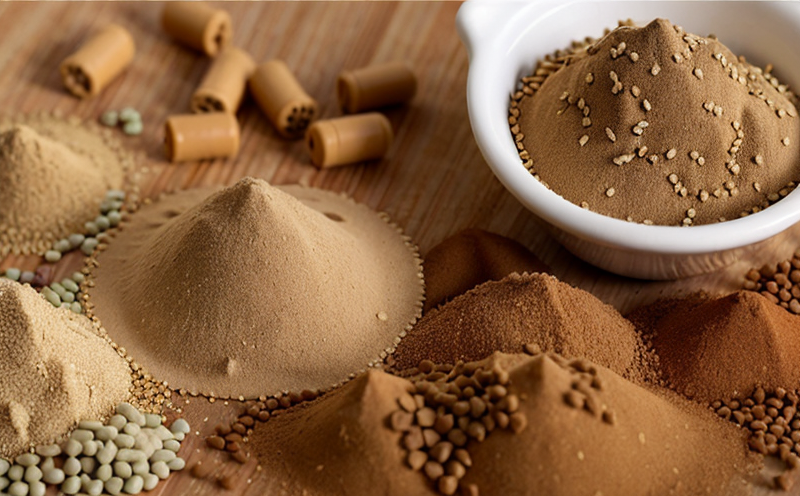Florfenicol Residue Testing in Animal Feed
The demand for safe and sustainable animal feed is paramount in modern agriculture. Florfenicol, an important veterinary drug used to treat bacterial infections in animals, can leave residues in food products if not properly monitored. Ensuring that florfenicol levels do not exceed allowable limits is critical to maintaining public health and complying with regulatory standards.
The testing of florfenicol residues in animal feed involves a series of meticulous steps designed to provide reliable results. This process begins with the collection of samples from various sources, including farms, processing plants, and retail outlets. Once collected, these samples undergo extensive preparation before undergoing analytical testing. The selection of appropriate sample types is crucial for ensuring accurate residue levels.
Commonly used methods for florfenicol residue detection include Liquid Chromatography-Mass Spectrometry (LC-MS/MS) and Enzyme-Linked Immunosorbent Assay (ELISA). LC-MS/MS offers high sensitivity and selectivity, making it suitable for identifying low levels of florfenicol. ELISA provides rapid results and is often used as a screening tool due to its ease of use.
Sample preparation plays a significant role in the accuracy of the test results. This involves extracting florfenicol from the feed matrix using solvents like acetonitrile or methanol, followed by clean-up steps such as solid-phase extraction (SPE). These techniques help remove interfering substances, ensuring that only florfenicol is detected.
After sample preparation, the extracted florfenicol undergoes analysis. The chosen method ensures precise quantification of florfenicol residues according to international standards like ISO 16540-3:2017 or AOAC Official Method 998.06. Compliance with these standards guarantees consistent and reliable results.
The final step in the process is reporting the findings. This includes providing detailed reports that outline the sample identification, extraction method, analytical technique used, and the detected florfenicol levels. Compliance officers can use this information to make informed decisions about feed safety practices.
- Sample Collection: From farms, processing plants, retail outlets
- Preparation Techniques: Solvent extraction, solid-phase extraction
- Analytical Methods: LC-MS/MS, ELISA
- International Standards: ISO 16540-3:2017, AOAC Official Method 998.06
The importance of accurate florfenicol residue testing cannot be overstated. It helps ensure that animal products are safe for consumption while adhering to regulatory guidelines. By employing state-of-the-art techniques and adhering to stringent quality control measures, laboratories can provide reliable results that contribute to the overall health and safety of consumers.
Why Choose This Test
Selecting florfenicol residue testing is essential for several reasons:
- Regulatory Compliance: Ensures adherence to international standards like ISO 16540-3:2017 and AOAC Official Method 998.06.
- Public Health Protection: Prevents potential health risks from consuming contaminated animal products.
- Sustainability: Supports the sustainable production of safe, high-quality animal feed.
- Informed Decision-Making: Provides data that helps quality managers and compliance officers make informed decisions about feed safety practices.
By opting for florfenicol residue testing, laboratories can demonstrate their commitment to maintaining the highest standards of food safety. This not only enhances customer trust but also ensures regulatory compliance and promotes a safer food supply chain.
Quality and Reliability Assurance
At our laboratory, we prioritize quality and reliability in all our testing processes. We employ trained professionals who are well-versed in the latest techniques for florfenicol residue detection. Our state-of-the-art facilities ensure that every sample is handled with precision and care.
We use only high-quality reagents and instruments to guarantee accurate results. Regular calibration of equipment and adherence to strict quality control measures further enhance our reliability. Our team continuously updates their knowledge through ongoing training programs, ensuring they are equipped with the latest methodologies and best practices.
Our commitment to excellence extends beyond just technical proficiency. We also focus on timely delivery of reports and transparent communication throughout the testing process. This ensures that stakeholders have access to reliable data when needed.
Customer Impact and Satisfaction
The results of florfenicol residue testing directly impact customers by ensuring they receive safe, high-quality animal feed products. For quality managers and compliance officers, accurate test results provide valuable insights into the safety of their products. R&D engineers can leverage these data to optimize production processes, reducing the risk of contamination.
Our service not only supports regulatory compliance but also enhances customer trust by delivering consistent, reliable results. This is particularly important in markets where consumer confidence plays a crucial role in business success. By choosing our florfenicol residue testing service, customers can rest assured that they are receiving products that meet the highest safety standards.





